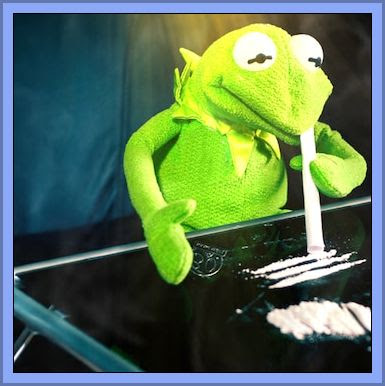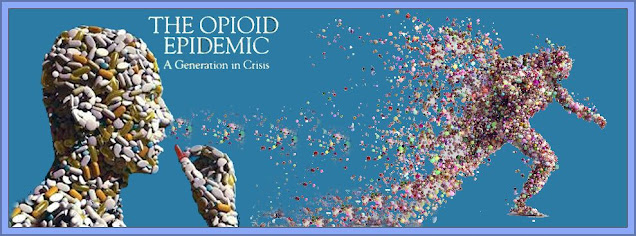 |
| Kermit On Drugs - No Laughing Matter. |
...... Just 406 people live in Kermit. Its hard to grasp those figures ... but its true.
Of course its not really just the Tug Valley where prescription churning became a big business, but actually part of wider problem across large swathes of the country, where for every one million Americans, almost 50,000 doses of opioids are taken every day. That's four times the rate in the UK. Opid addiction and overdose deaths have quadrupled in the US since 1999, and in 2017 addiction was linked to 28,000 deaths (out of 72,000 drug overdose deaths), devastating families and whole communities like poor little Kermit along the way.
For example Huntington, West Virginia (pop 47,079 -2017), has:
- 10 times more overdose deaths than the the national average.
- More than 1 in 10 babies born the town are born suffering from the symptoms of drug withdrawal.
- On one day alone, the 15th August 2016, it saw 28 overdoses in just one project (public housing).
Heroin for example, is an illegal opioid, but most opioids in the US are actually prescription versions e.g. Codeine and Morphine are opioids, painkillers that are available from a pharmacy on prescription. However over use of such drugs, act as gateways to addictions to these, and the illegal street versions.
 |
| The US Opioid Crisis Is A Generational Crisis ..... |
According to some critics, a major reason for the over prescribing of opoids can be pointed at American medical school teaching for doctors, which has only just started covering pain management, and the dangers of opoid addiction ... the doctors trained a few years ago didn't learn anything on these subjects, and often remain ill informed on the subject.
Because feeding this medical ignorance is the fact that unlike most Europeans, Americans must get their own health coverage via an insurance company. Usually they do so from their employer or the government. These insurance packages, especially for the poorer population, usually won't pay for any treatment except emergency, and offer little post pain treatment, but a pill. So for example, instead of say, physical therapy for back spasms, the doctors will prescribe opoids.
The US Center for Disease Control and Prevention (CDC), says that opioid prescriptions in the US have fallen by 18 per cent per annum, from their peak in 2010, however that reduced figure is still three times higher than in 1999. The American Medical Association (AMA), called for a ban on media adverts for prescription opoid drugs in 2015. The call fell on deaf ears, and the drug TV advertising expenditure reached $6.4 billion in 2016, culminating with the half-time Super Bowl's main TV advert slot that year going to a 60-second AstraZeneca advert, devoted to opioid-induced constipation treatment issues.
The drug companies will often encourage US doctors to prescribe drugs, by paying for doctors and teaching hospital staff to attend conferences and junkets, with free travel, research costs, gifts, speaking fees, and meals etc. In 2016 more than 630,000 US physicians had payment records, totalling more than $8bn received in cash or kind, from the drug companies. As a comparison, in 2016 in the UK, the same drug companies gave around £116m ($153m) to health workers and organisations for non-research and development.
So the Kermit's and Huntington's of the US are common .... Worryingly the increased use of Fentanyl (50 to 100 times stronger than morphine - a prescription drug which can only be approved in the US for severe pain arising in cases such as cancer treatment), being laced into less powerful narcotics, including cocaine and synthetic heroin, is fuelling another surge in opoid usage in the USA.
The drug is legally imported from China, but also increasingly illegally smuggled into the USA, via orders on the Internet and then sent by post, either directly to the US or to trafficking networks based in Mexico. The US government has blamed China for the surge of it on the streets, and its increased presence in drug busts. While China has blamed the growing drug demand in the US as the real problem. However Beijing has in the past used tax breaks to encourage fentanyl production, and over production may be a factor in its ease of supply.
The truth is that the War on Drugs, will only be won by cutting demand .... the US will fight a losing battle until it realises that it is the worlds biggest drug market ... both legal and illegal.








North America is still in the midst of a toxic drug crisis. Fatal overdoses peaked above 112,000 in the US for the first time in 2023.
ReplyDelete